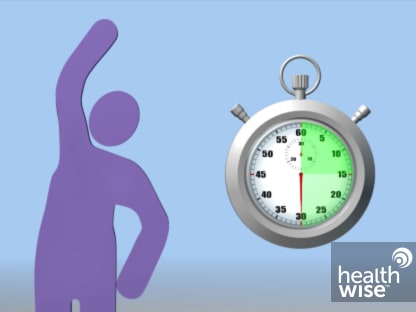Fitness: Adding More Activity to Your Life
Overview
Being active is one of the best things you can do to get fit and stay healthy. It helps you feel stronger and have more energy. It can help you lose fat, build muscle, and reach a healthy weight. Being active may also help you feel better, sleep better, and focus.
How do you get started with adding more activity?
Experts recommend at least 2½ hours of moderate activity, or 1¼ hours of vigorous activity each week to stay healthy. Here are some ideas that can help you get started.
- Work with your doctor to create a plan that is right for you.
- Make sure to start slowly. If you're not active at all, work up to it. Set small goals.
- Walking is one of the easiest and cheapest ways to get moving for most people.
- Keep track of the number of steps you take each day. You can use a phone app or a pedometer.
- It's fine to be active in shorter periods of time throughout your day and week that add up to the recommended goals.
- It's important to find activities that fit your lifestyle and your personality. Joining a group or a class can help keep you motivated. Many people find that everyday activities are easier to keep doing.
Health Tools
Health Tools help you make wise health decisions or take action to improve your health.
Adding Activity
Like any lifestyle change, adding activity to your daily routine is easier if you have a plan. Experts recommend doing moderate to vigorous activity to get and stay healthy. Work with your doctor to create a plan that is right for you. Start slowly. And set small goals.
- Start with walking.
- For most people, walking is one of the easiest and cheapest ways to get moving.
- Keep track of the number of steps you take each day. You can use a phone app, a fitness tracker, or a pedometer. Tracking can help you see the progress you're making toward your goals. That progress might inspire you to move more.
- Work up to a comfortable level.
Even small amounts of activity add up.
- It's fine to be active several times throughout your day and week.
- If you're not active at all, work up to it. You may want to start by walking around the block every morning, or walking for just 10 minutes. Over time, you can make your walks longer or walk more often throughout your day and week.
- Do activities you like.
Find activities that fit your lifestyle and your personality. For example:
- Do you like to be active on your own or with others?
- Joining a group or a class helps some people stay motivated.
- Do you like structured activities like classes, or everyday activities like gardening?
- Many people find that everyday activities are easier to fit into their life. Others are more likely to stay with an activity if it requires them to show up for a class or for a game.
- How much money, if any, do you want to spend on gear or other expenses?
- There are activities to match every budget. You can walk around your neighborhood without spending any money. You may be able to join a community swimming, dancing, or tai chi class for a small fee.
Learn more
Watch
Setting Goals
You can make physical activity part of your daily life, just like brushing your teeth or going to work. It's not easy to change habits. But taking the time to really think about what will motivate or inspire you will help you reach your goals.
Try these tips for setting goals. As you develop your goals, write them down.
- Focus on small goals.
This will help you reach larger goals over time. With smaller goals, you'll have success more often, which will help you stay with it.
- Write down your goals.
This will help you remember, and you'll have a clearer idea of what you want to achieve. Post your plan where you will see it often. It's a reminder of what you're trying to do.
- Make your goals specific.
Specific goals help you measure your progress. For example, setting a goal to take a half-hour walk 3 days a week is better than a general goal to "walk more."
- When you reach a goal, reward yourself.
Celebrate your new behavior and success for several days. Then think about setting your next goal.
Learn more
Getting Past Barriers
Most people struggle at times with getting active—and staying active over time. All kinds of things can get in the way. Keys to getting past these barriers include:
- Finding out what's getting in your way.
-
Maybe you're stressed or busy. Knowing exactly what's holding you back can help you figure out how to get past that barrier.
- Thinking of ways to get past your barriers.
-
For example, if you're busy, try adding an activity to routines you already have, like walking after meals. Or exercise in 5- or 10-minute chunks.
- Deciding what barrier to work on first.
-
Pick one thing you'll work on this week, like fitting in a short walk at lunch. This can be a small step toward a bigger goal.
- Staying on track.
-
Keep going. But if you feel stuck, find a new activity you like, exercise with a friend, or use an app or journal to track your activity.
Learn more
Building Support
For many people, support from others is a key to success. Staying active is easier when you're doing something you like with people you like to spend time with.
Here are some ways to connect with others:
- Make a list of who could help you.
-
Connecting with others can make getting active easier and more enjoyable.
- Find a partner.
-
What activities would you enjoy doing with a friend or family member?
- Ask for encouragement.
-
Consider asking a friend to check in with you once a week. Words of encouragement can make a difference.
- Learn from past support.
-
When you've gotten help with past challenges, what was the most useful? How can you use that now?
- Get help with the details.
-
This might include getting a ride or arranging for child care.
- Join a class or use a fitness app.
-
Some people use social media or apps to connect with others and stay on track.
Related Information
Credits
Current as of: September 24, 2025
Author: Ignite Healthwise, LLC Staff
Clinical Review Board
All Ignite Healthwise, LLC education is reviewed by a team that includes physicians, nurses, advanced practitioners, registered dieticians, and other healthcare professionals.
Current as of: September 24, 2025
Author: Ignite Healthwise, LLC Staff
Clinical Review Board
All Ignite Healthwise, LLC education is reviewed by a team that includes physicians, nurses, advanced practitioners, registered dieticians, and other healthcare professionals.







